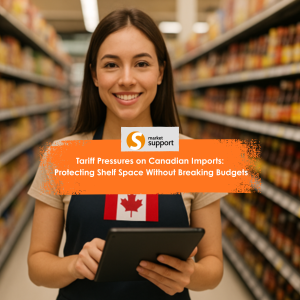Tariff Pressures on Canadian Imports: Protecting Shelf Space Without Breaking Budgets
 The grocery aisle has always reflected global economics. In 2025, Canadian CPG brands are feeling the weight of trade tensions and global tariffs more directly than ever. With U.S. tariff adjustments, European agricultural fees, and global supply chain disruptions still echoing from the pandemic era, the cost of importing goods into Canada is rising.
The grocery aisle has always reflected global economics. In 2025, Canadian CPG brands are feeling the weight of trade tensions and global tariffs more directly than ever. With U.S. tariff adjustments, European agricultural fees, and global supply chain disruptions still echoing from the pandemic era, the cost of importing goods into Canada is rising.
Statistics Canada reports that import prices rose 6.2% in Q2 2025 compared to the same quarter in 2024 (StatsCan, 2025). For CPG companies, that increase isn’t just an accounting headache, it directly threatens shelf presence, profitability, and consumer loyalty.
The Impact of Tariffs on Canadian CPG Companies
Tariffs increase landed costs for imported goods. For Canadian CPG leaders, this creates a perfect storm:
- Higher input costs that must either be absorbed or passed on to consumers.
- Reduced promotional flexibility as marketing budgets are squeezed.
- Shelf competition with domestic or alternative brands that may be better priced.
At the same time, consumers remain extremely price-sensitive. In August 2025, food inflation was still 4.3% higher year-over-year (StatsCan, 2025). That means shoppers are not willing to forgive higher price tags, especially for staples.
The result? Tariffs don’t just squeeze margins; they risk your physical spot on the Canadian grocery shelf.
Shelf Space as a Strategic Asset
In retail, shelf space is more than square footage, it’s your brand’s real estate in front of millions of consumers. Losing it to a competitor is costly and often difficult to recover.
Deloitte Canada (2025) estimates that Canadian CPG companies lose an average of 11% of annual sales when shelf space is reduced due to cost pressures or compliance failures. In an era of tariff volatility, protecting that space is not optional, it’s existential.
Why Merchandising Execution Matters Under Tariff Pressure
When costs rise, brands can’t afford execution failures. Creative displays or flashy promotions won’t matter if planograms aren’t followed, products aren’t rotated, or shelves sit empty.
Field execution is the frontline defense:
- Planogram compliance ensures retailers see you as reliable, not replaceable.
- Shelf audits confirm that your products are present and priced correctly.
- Stock rotation prevents waste and maximizes sell-through.
Without consistent execution, tariff-driven cost hikes compound into lost sales.
The Role of AI in Managing Tariff Challenges
2025 is the year AI stops being “nice to have” in merchandising. McKinsey (2025) found that AI-enabled supply and merchandising strategies can reduce waste and inefficiency by up to 18%, helping offset cost pressures like tariffs.
Practical examples include:
- AI shelf scanning: Identifying compliance gaps in real time.
- Predictive replenishment: Anticipating when and where stock-outs will occur.
- Dynamic pricing intelligence: Benchmarking against competitors to prevent mispricing that costs loyalty.
With tariffs squeezing budgets, efficiency becomes strategy. AI offers a measurable path to doing more with less.
Canadian Case Study: Tariffs and Beverage Imports
In 2025, beverage imports have become a flashpoint. New U.S. tariffs on aluminum packaging increased costs for canned beverages by 7% year-over-year (Bloomberg, 2025). For energy drink and hydration brands competing in crowded Canadian categories, the result has been a scramble for shelf presence.
Retailers are increasingly unwilling to allocate space to SKUs with supply risks. Brands that can demonstrate strong merchandising compliance and reliable in-store availability are the ones maintaining position, even with higher costs.
Strategies to Protect Shelf Space Without Breaking Budgets
For CPG leaders navigating tariffs, the playbook is clear:
- Double Down on Execution: A national field team ensures compliance and prevents costly out-of-stocks.
- Leverage AI Tools: Real-time visibility and predictive insights offset the margin squeeze.
- Prioritize High-Impact SKUs: Focus execution on the 20% of SKUs driving 80% of your Thanksgiving-through-holiday sales.
- Collaborate with Retailers: Transparency on supply chain challenges helps preserve trust and space.
The Bottom Line: Tariffs Test Execution, Not Just Budgets
Tariffs are here, and they’re not going away anytime soon. For Canadian CPG executives, the challenge isn’t just financial, it’s strategic. Shelf space in 2025 is harder to win, easier to lose, and more expensive to protect.
Those who embrace AI-powered merchandising execution and national field coverage will safeguard their presence without blowing through budgets. Those who don’t may see their competitors quietly take over their shelf real estate.
In a tariff-heavy environment, execution is your insurance policy. Visit www.marketsupport.ca for more information.
« Back to Blog